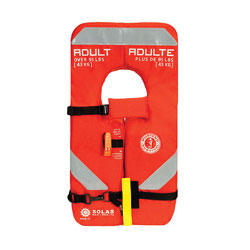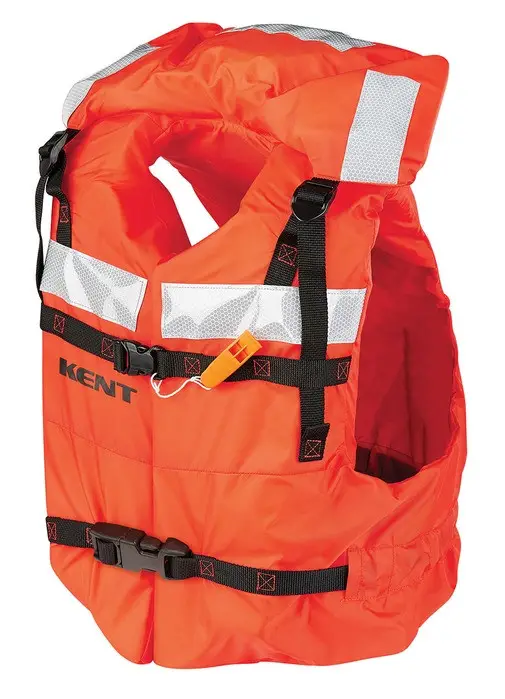A Type 1 PFD, or personal flotation device, is the most buoyant type of PFD available. It is designed to turn an unconscious person face-up in the water, and it is suitable for all water conditions, including rough or isolated water where rescue may be delayed. Type 1 PFDs are typically made of foam or inflatable material, and they have a large surface area to help keep the wearer afloat. They are also typically equipped with a whistle and a light, which can be used to signal for help.
Type 1 PFDs are required by law to be worn on all commercial vessels, and they are also recommended for recreational boaters who are participating in activities that pose a risk of falling overboard, such as fishing, water skiing, and tubing.
Here are some of the benefits of wearing a Type 1 PFD:
- Increased buoyancy: Type 1 PFDs are the most buoyant type of PFD available, which means they are better at keeping you afloat.
- Automatic turn-over feature: Type 1 PFDs are designed to turn an unconscious person face-up in the water, which can help to prevent drowning.
- Large surface area: The large surface area of a Type 1 PFD helps to keep you afloat, even in rough water.
- Whistle and light: Type 1 PFDs are typically equipped with a whistle and a light, which can be used to signal for help.
If you are going to be boating, it is important to wear a Type 1 PFD. It could save your life.
Most people are familiar with the term “life jacket,” but not everyone knows there are different types of life jackets. The type 1 personal flotation device (PFD), also known as an offshore life jacket, is a specialized piece of safety gear designed for boaters who venture far from shore. Here’s what you need to know about type 1 PFDs.
A type 1 PFD is much more buoyant than a standard life jacket, and it will keep your head above water even if you’re unconscious. That’s because type 1 PFDs are made with closed-cell foam that doesn’t absorb water. They also have a higher back panel to support your head and prevent it from rolling forward in the water.
In addition to being more buoyant, type 1 PFDs are also more comfortable to wear for extended periods of time. That’s because they typically have adjustable straps that allow you to customize the fit, and many also have padded shoulders for added comfort.
If you plan on spending any time on the open water, a type 1 PFD is essential safety gear.
There are many different types of life jackets, or Personal Flotation Devices (PFDs), available on the market today. While most people are familiar with the traditional orange PFDs, there is also a type 1 PFD designed for more serious water activities. Here is a closer look at the type 1 PFD and what it has to offer.
The type 1 PFD is considered to be the best option for rough waters and open-sea conditions. It is highly visible and provides superior buoyancy, making it ideal for those who might find themselves in difficult situations. This type of PFD is also equipped with a hood and crotch straps to keep the wearer safe and secure.
While the type 1 PFD is not required by law in all states, it is always a good idea to have one on hand when embarking on any kind of water activity. You never know when you might need it, so it’s better to be safe than sorry!

Credit: defender
What is Type 1 Pfd
A personal flotation device (PFD) is a piece of equipment worn by someone to provide buoyancy in water and prevent drowning. There are different types of PFDs, and each has its own advantages and disadvantages.
Type 1 PFDs are also known as offshore life jackets.
They are designed for use in rough waters where there is a chance of being swept away or knocked unconscious. Type 1 PFDs will keep you afloat even if you are unconscious, and they have more buoyancy than other types of PFDs. However, they can be bulky and uncomfortable to wear, and they may make it difficult to swim or move around in the water.
If you are planning on spending time near or in the water, it is important to choose the right type of PFD for the conditions. If you are unsure about which type of PFD to choose, ask a lifeguard or another expert for advice.
How Does Type 1 Pfd Work
A type 1 PFD, also called a life jacket, is a personal flotation device that is wearable and designed to keep the wearer’s head above water in the event of an emergency. The most common type of life jacket, type 1 PFDs are typically made from foam or other buoyant materials and can be found in a variety of sizes to fit both adults and children. Some type 1 PFDs even have additional features like built-in whistles or reflective strips to help make the wearer more visible in low-light conditions.
In general, type 1 PFDs work by keeping the wearer afloat in water through a combination of buoyancy and body position. When worn correctly, a type 1 PFD will support the head and neck while keeping the rest of the body relatively upright in the water. This allows the wearer to float without tiring and makes it easier to breathe while also reducing the risk of hypothermia.
Of course, no personal flotation device is 100% effective and there are some risks associated with wearing one. For example, if not properly secured, a type 1 PFD can ride up around the face and actually make it more difficult to breathe. Additionally, some people may feel claustrophobic or uncomfortable when wearing a life jacket due to its constrictive nature.
However, these risks are generally outweighed by the benefits of having this extra layer of safety when out on the water.
So whether you’re enjoying a day at the lake or sailing across an ocean, be sure to strap on your trusty type 1 PFD before heading out!
What are the Benefits of Using Type 1 Pfd
There are many benefits of using a Type 1 personal flotation device (PFD), also known as a life jacket. Wearing a PFD can help to keep you safe in the water and increase your chances of survival if you find yourself in an emergency situation. Here are some of the key benefits of wearing a Type 1 PFD:
1. Increased buoyancy – A Type 1 PFD will provide much more buoyancy than a standard swimsuit or t-shirt, helping to keep your head above water even if you are unconscious or fatigued.
2. Protection from the elements – A PFD can help to protect you from cold water and waves, providing essential insulation in an emergency situation.
3. Reduced risk of drowning – Wearing a PFD significantly reduces the risk of drowning, even for non-swimmers who may find themselves in water unexpectedly.
Will Your Life Jacket Save You? PFD Testing
Conclusion
There are three main types of personal flotation devices (PFDs): Type I, Type II, and Type III. PFDs are required by the U.S. Coast Guard to be worn on boats 20 feet or longer in length while underway, and on all boats operating in federal waters. All PFDs must be USCG-approved and in good condition.
Type I PFDs, also known as offshore life jackets, are designed for long periods of time in rough water conditions with little or no chance for rescue. They provide the most buoyancy and turn an unconscious person face-up in the water. Type I PFDs are typically bright orange in color so they can easily be seen by rescuers.
Type II PFDs, also called near-shore vests, are intended for use in calm waters where there is a good chance of being rescued quickly if you fall overboard. They will turn some unconscious people face-up but not all, so they should only be used when there is a high likelihood of being rescued within minutes. Type II PFDs are usually bright yellow or green so they can be easily seen by rescuers.
Type III PFDs, also called flotation aids or recreational vests, are designed for use in relatively calm waters where there is a good chance of being rescued quickly if you fall overboard. They will not turn an unconscious person face-up but do provide more buoyancy than a life jacket alone.
Related: Type 3 Pfd
